There are hundreds of different glass collectibles in the world. However, some pieces are worth more than others. So where does carnival glass fall in the spectrum of value?
Most carnival glass pieces sell for between $15 – $35. However, there are plenty of carnival glass pieces and sets of rarer colors and patterns that sell for between $100 – $300, a little less than 10% carnival glass sales. There are also several thousand carnival glass pieces (less than half a percent of sales) that have sold for over $1,000 over the past 20 years or so.
Whether you want to build your carnival glass collection or have a collection you want to sell, you’ve come to the right place. Below we’ll discuss how much carnival glass is worth and how to sell it!
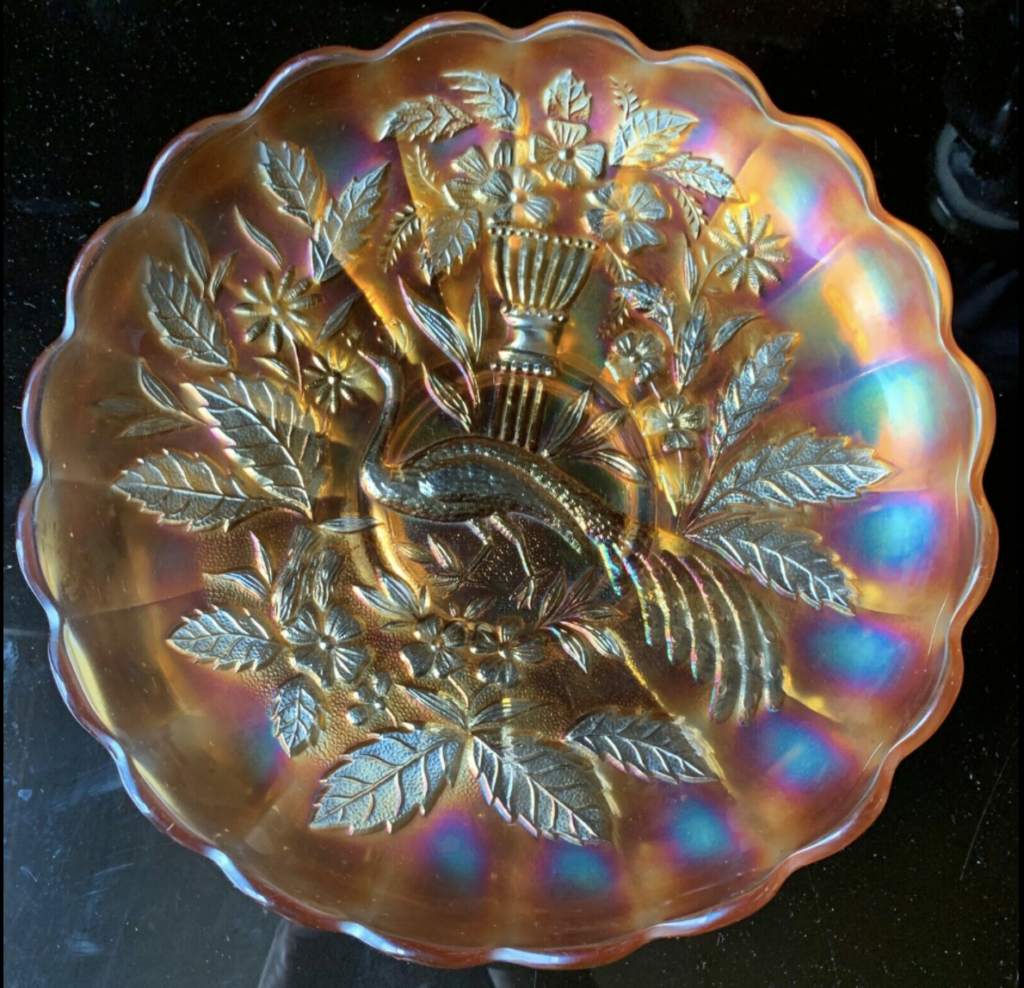
Carnival Glass: What Is It?
Carnival glass was first made in the early 1900s by the Fenton Art Glass Company. John W. Fenton was inspired to make these pieces after seeing the pieces made by glass blowers.
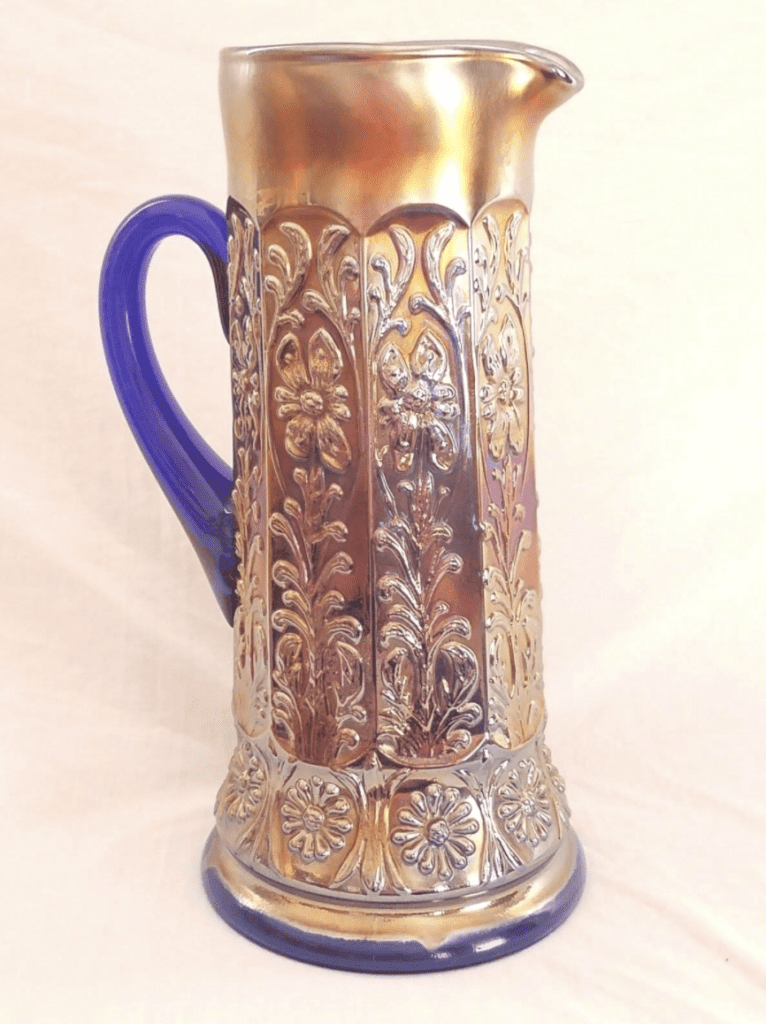
Carnival glass is named after the location where it was given out most often: at carnivals. Families rarely used carnival glass pieces during mealtimes. These colorful pieces were better suited as decorations.
Some of the earliest carnival glass producers include Dugan and Northwood. When Fenton first produced these pieces, they called them Iridill for their iridescent qualities. These iridescent, multicolored characteristics come from the glaze. That said, Northwood carnival glass pieces tend to be the most popular.
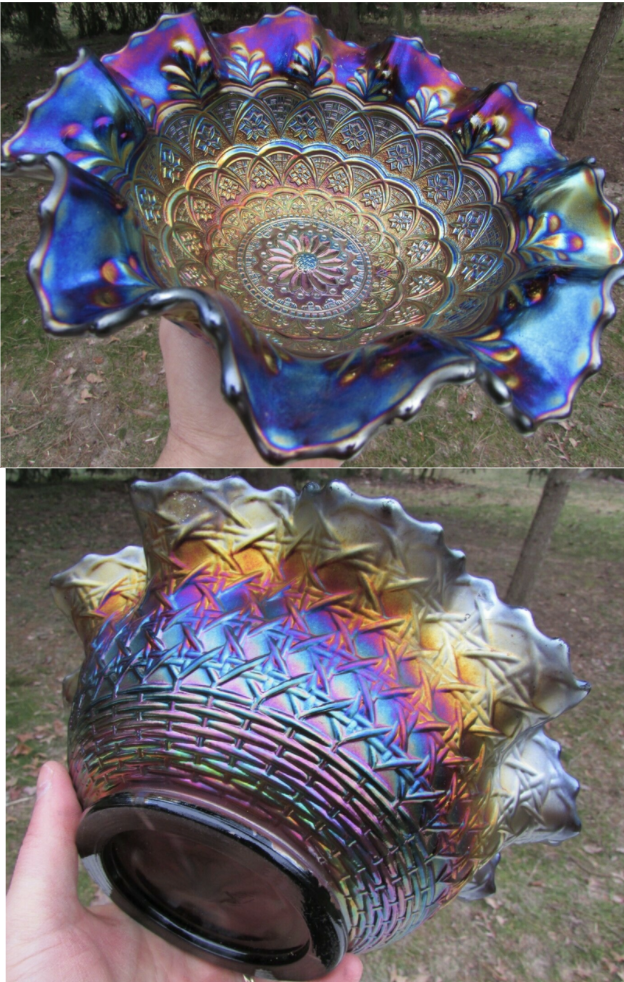
Early 1900s carnival glass creations are now valued by collectors for their rarity and uniqueness. Every carnival glass piece is different from the other. The chemical glaze mixture will react in the heat differently every time. There are a variety of carnival glass pieces out there. Some pieces include goblets, pitchers, cups, platters, and candy dishes.
Carnival glass regained its popularity in the 1950s. While glassmakers started producing these unique pieces again, collectors prefer the original vintage pieces. We’ll discuss how to identify modern carnival glass from the vintage carnival glass in a later section.
It is important to note that carnival glass does not contain any lead. However, many vintage glass glazes from that time period contained dangerous levels of lead.
Carnival Glass: How Much Is It Worth?
Because carnival glass is such a desirable collector’s item, it can be quite valuable. However, more common pieces will sell for only $15 – $35.
So how do you determine how much your carnival glass pieces are worth? The exact value of your piece is determined by the rarity of the piece and its color pattern.
As you can imagine, original vintage pieces made in the early 1900s are worth more than the reproduction pieces.

Carnival glass pieces have a variety of color mixtures; however, each one has a single base color. Collectors use the base colors to determine the value of the piece. More popular colors include marigold (the most common color), green, amber, blue, and amethyst.
However, the rarer carnival glass colors, which are worth more, are red, peach, and aqua. Look at the bottom of the piece to identify its base color if you’re unsure.
Marigold carnival glass pieces were referred to as Golden Iris when first produced. Because there are so many marigold pieces in the market, they are typically worth the least.
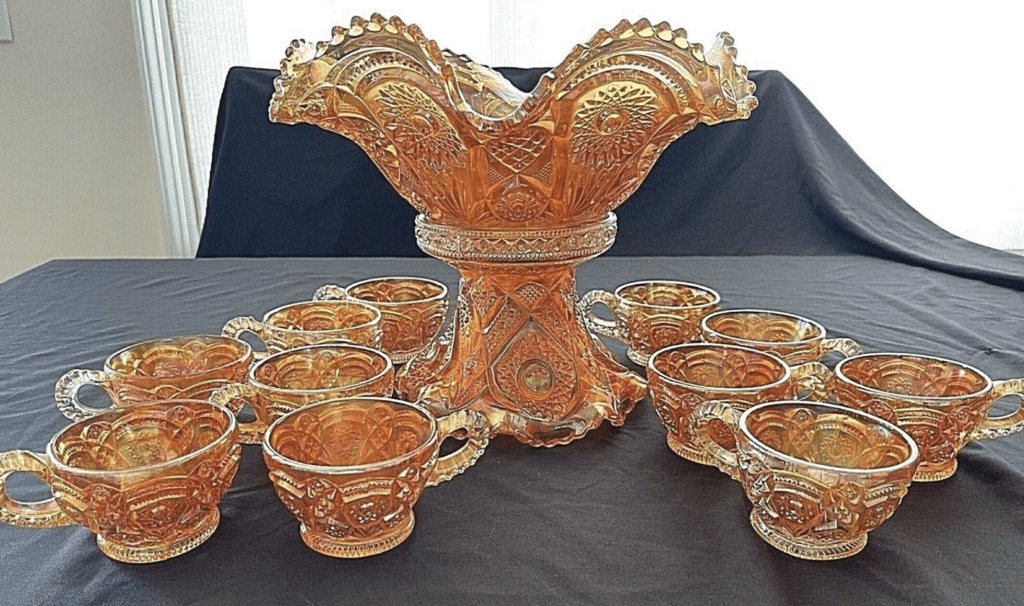
Carnival glass pieces are worth more when sold in sets. Other factors that affect the value of your carnival glass piece are its pattern and condition.
Pieces that are fading or that have cracks and chips will sell for less than those in perfect condition. But what about patterns?
Carnival glass has been produced in more than 2,000 different patterns. The most valuable carnival glass patterns are Fenton’s peacock and urn, Northwoods grape and cable, and Dugan’s Farmyard. Some other valuable carnival glass patterns include the following:
- Question Marks by Dugan
- Beaded Spears by Jain
- Australian Kookaburra and Kingfisher by Crown Crystal
- Diving Dolphins by Sowerby
- Smooth Rays by Fenton
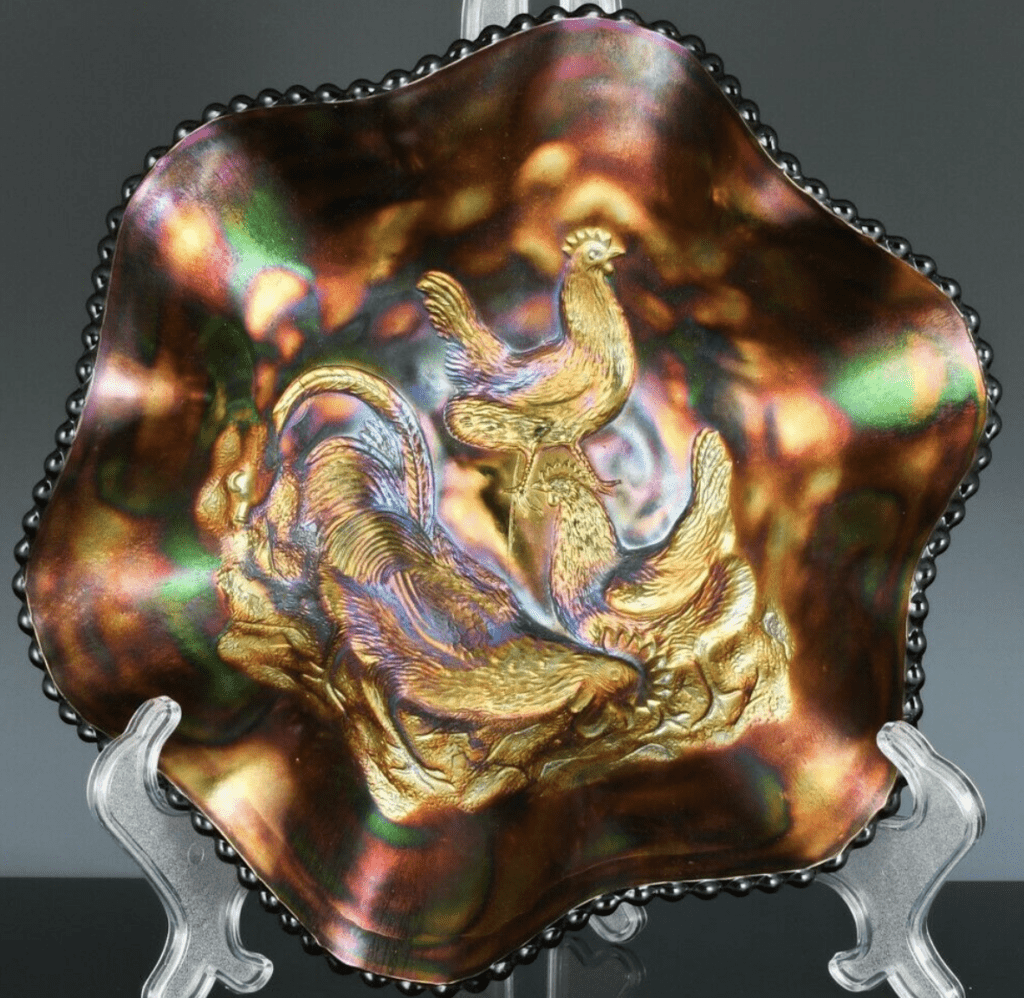
Specialty patterns, such as the Cleveland Memorial pattern, are much rarer than those produced for everyday sales. In other words, they will be more expensive. For example, the Cleveland Memorial Souvenir Ashtray in Marigold is worth $55,000.
Unlike other glass pieces produced during this time period, carnival glass patterns were machine pressed, not hand-made. However, the dish shape was hand-formed.
Even if your carnival glass pattern isn’t one of the most valuable, it could help you identify its age. Certain patterns were most common during specific time periods.
What are the most valuable Carnival Glass pieces?
One of the most expensive pieces of carnival glass on eBay is the Northwood Aqua Opal Peacocks & Urn Master Ice Cream Bowl. This piece is listed for $45,000, but that doesn’t even include the $200 shipping fees.
Why is this piece so valuable? First of all, it uses one of the rarest base colors: aqua. Additionally, it is a rarer dish. But most importantly, it has the peacock and urn pattern on it. The dish’s pattern is just as important as the color and piece type itself. This unique pattern was among the first carnival glass productions. Because this pattern is so valuable, many attempt to replicate it. Be cautious when purchasing a peacock patterned carnival glass for a large sum of money.
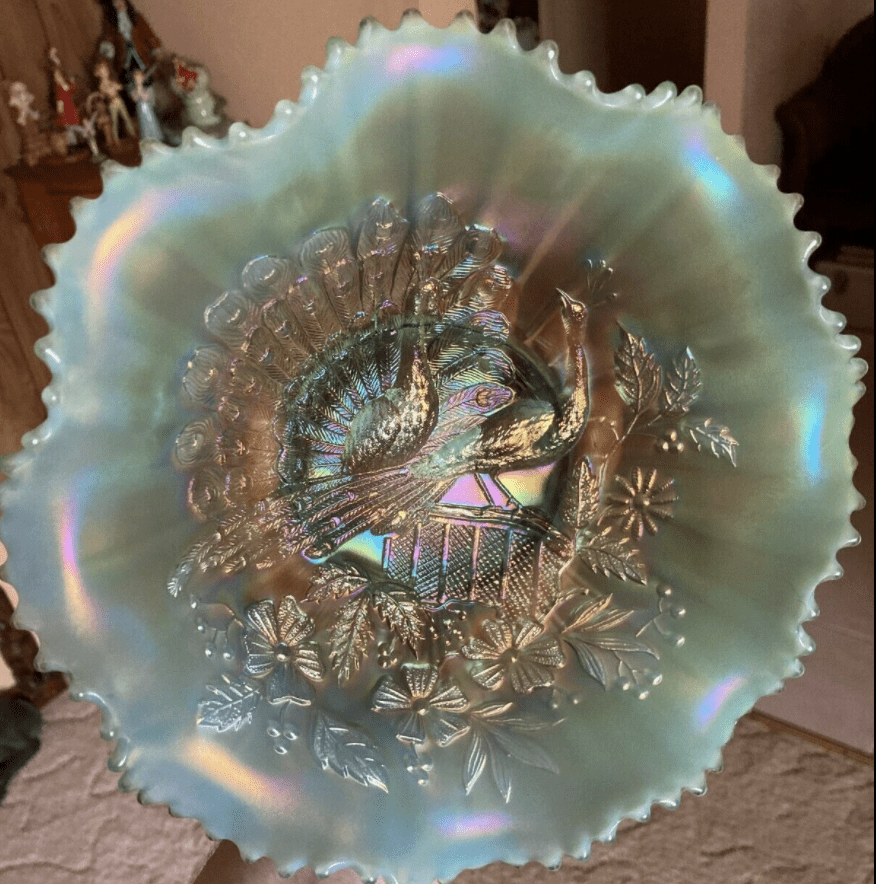
While this peacock piece costs a fortune, it’s not the most valuable carnival glass piece to date. So what is?
The Millersburg Peoples Vase in Blue is the most valuable piece of carnival glass. In fact, this piece has been named the most iconic carnival glass ever made. This piece sold for $155,000 at auction in 2018.
The Millersburg carnival glass vase is followed closely in value by the Northwood Wisteria Vase in Emerald Green. This brightly colored vase sold for $140,000 just a few months after the Millersburg Peoples vase set the record for the most valuable piece of carnival glass (again).
The third most valuable carnival glass piece is the Northwood Peacock and Urn Stippled Large ICS Bowl in Vaseline. According to the Hooked on Carnival auction site, there are only two of these pieces in existence. Since this piece is so rare, it is worth $66,000.
What’s the most common Carnival Glass piece?
As mentioned earlier, marigold pieces are the most common carnival glass color. Additionally, candy dishes are some of the most popular carnival glass dishes. There are several carnival glass candy dishes listed for less than $10 on eBay.
While marigold and candy dish carnival glass pieces are the most common, combining the two items doesn’t necessarily mean the piece will be inexpensive.
The most expensive candy dish listed on eBay is the Fenton Dragon & Lotus Carnival Glass Ruffled Candy Dish in Marigold. This piece is listed at $600. While this isn’t the most expensive carnival glass piece, it certainly isn’t the least valuable.
How to Identify Real Carnival Glass
Because many carnival glass pieces are extremely valuable, people have begun producing fakes. Fake carnival glass pieces were first made in the 1980s. This was about the time that glass collectors gained interest in carnival glass pieces.
If you’re going to be a carnival glass collector, then you need to know how to identify fake pieces from originals. Doing so requires extensive knowledge of carnival glass patterns and colors.
The most noticeable sign that you’re looking at a fake carnival glass piece is strange coloring. Because fakes don’t use cheap chemical treatments to create the shimmering luster of the pieces, they oxidize over time. As the piece oxidizes, its many colors will begin to turn an unsightly shade of reddish-brown or green.
Worried the piece you’re looking at is a fake? Ask the seller if they’re willing to hold the piece for you for a few days, or even a week. When you return to examine the piece, pay special attention to any change of color.
In addition to oxidization, fake carnival glass pieces use duller colors than the originals. Using color to authenticate your carnival glass pieces is a bit complicated.
Another method for identifying fakes is looking at the bottom marker. Many glass companies put their logo on the bottom of the piece along with some other production information. However, most early carnival glass didn’t feature company markings. That said, Northwood Carnival Glass has always put markings on their pieces.
The Northwood symbol is a capital “N” underlined inside a circle. (Source). Many fakes attempt to trick collectors by using the “N” marker; however, they don’t use the circle. If your piece is dated circa 1912 “n” it’s a fake.
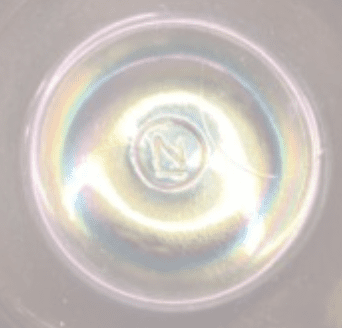
While examining the bottom marker, look at the color of bottom ring. Authentic carnival glass pieces let some light pass through them. Meanwhile, faked pieces tend to be more opaque.
If you’re going to collect carnival glass, you need to become a pattern connoisseur. Fake carnival glass pieces rarely have perfect patterns. In other words, closely examining the pattern for missing or added details could help you identify a fake item. Remember, the more sought after (and expensive) patterns are the ones most likely to be faked. Before you spend a couple thousand, or even a couple hundred dollars on a carnival glass piece, take the time to authenticate it.
What are some examples of things to look for in carnival glass patterns? Some collectors noticed that faked Good Luck patterns are missing a stem with flower buds. Another pattern mistake is associated with the Grape and Cable pattern. The original pattern features grapes consistently decreasing in size. Meanwhile, faked patterns have grapes all of the same size.

Last, but certainly not least, is the weight of the piece. As a collector, you’ll come across dozens of similar carnival glass items. If an item you’re considering buying feels heavier than a similar piece you’ve seen, it’s likely a fake. In addition to weight, you should compare piece sizes. While many companies manufactured similar items, they used somewhat consistent sizing. Fake carnival glass pieces may be bigger or smaller than the originals.
You don’t have to work alone to identify fake carnival glass pieces for your collection. There are dozens of collector groups willing to work with you to find commonly faked items.
Join a Facebook group such as the Carnival Glass Network, the Carnival Glass Lovers, or Vintage Glass Identification.
How and Where to Sell Carnival Glass
Once you have a carnival glass collection started, it’s time to start selling them! Common places to sell antique glass items are online auctions websites such as eBay. You could also list your items in an Etsy shop! Here people can purchase individual pieces or sets as you list them.
You could also find online antique dealers looking to purchase from private collections. For example, the Carnival Glass Shop will purchase rare items from you. You might even be able to find a trade from their carnival glass shop.
Facebook groups aren’t just for identifying fake carnival glass items. Join the Carnival Glass Buy and Sell group to list your carnival glass pieces. Be very careful when purchasing items from groups like this, since they could be fakes.
If you live near any antique shops, especially those that specialize in vintage glass, speak with them about purchasing items from your collection.
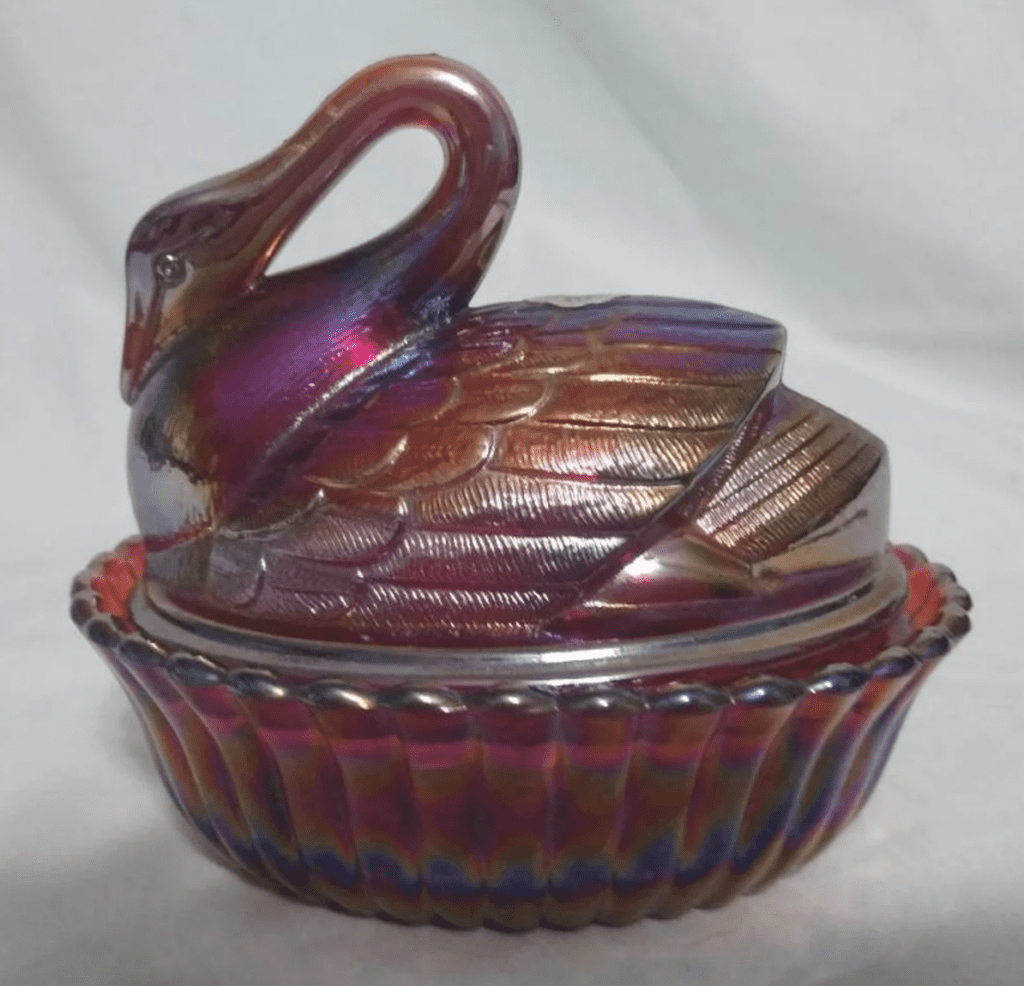
Another option for selling your carnival glass is traveling antique fairs. There are antique fairs all over the country. Register yourself in one of the antique fairs and bring some of your carnival glass pieces. This will also give you the opportunity to shop at other people’s booths!
In order to get the most money out of your carnival glass pieces, it’s best to have a document authenticating the piece’s value.
When selling your carnival glass pieces, don’t be afraid to haggle with customers. Try selling your items a little bit higher than their actual value. This leaves room for bartering with customers.
If you are struggling to sell any carnival glass pieces, you could always host a yard/garage sale. This is the best option if you only have low-value items such as cups, plates, and candy dishes.

